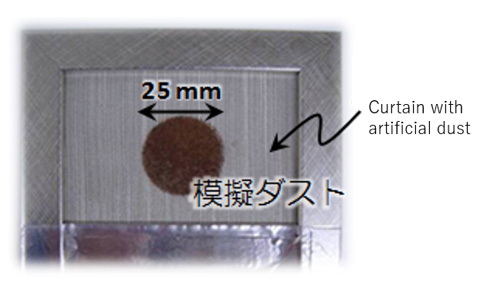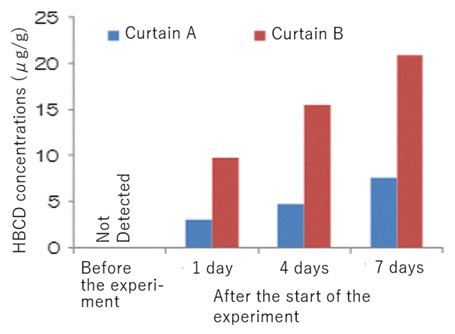- Waste management in Japan
- Circular economy in Japan
- Waste management in Asia
- Disaster waste management
Do Flame Retardants Directly Migrate to Indoor Dust?
Indoor dust is where indoor pollutants accumulate
Various chemical substances are accumulated in indoor dust. These chemicals are found inside houses and originate from a wide variety of sources such as home appliances, furniture, interior furnishing products, and construction materials. These sources also include items for our daily use such as toys, clothing and food, as well as items brought from outside such as dirt and dust.
Up to the present day, our research group has been conducting studies focused on flame retardants (FRs), which are chemicals added to materials to impart flame retardancy, in indoor dust. This article will introduce how the FRs transfer from flame-retarded products to indoor dust. These findings are part of our outputs from a collaborative research project with the Chemicals Evaluation and Research Institute (CERI), Japan1.
Migration pathways of chemicals from products to indoor dust
Indoor dust is a significant exposure pathway for infants, and global awareness has risen on this fact. However, neither mechanisms of product-to-dust transfer of chemicals nor the contribution of each chemical to dust is well understood. Presently, at least three transfer pathways are considered to exist.
The first pathway is that FRs evaporated from products (e.g., curtains) subsequently adsorb on dust. Generally, highly volatile chemicals tend to migrate into the indoor air, and substances with low volatility transfer to dust. Although FRs have relatively low volatility, it has been confirmed that they evaporate from products placed in a room. Once evaporated, FRs remain inside the room adhering to walls, floors and dust, though not staying in the air.
The second pathway is that torn or worn products containing FRs are broken into smaller fragments and directly incorporate into dust. When we closely observe the indoor dust under a microscope, we can find small plastic fragments including the ones with high content of FRs. Thus, this pathway has been scientifically verified2.
The third is a pathway that FRs transfer directly from products to attached dust. We have investigated this third pathway this time.
Experiment of attaching artificial dust to flame-retarded curtains
Are curtains in your house flame retardant? Previously, most commercially available flame-retarded curtains had been treated with a FR called hexabromocyclododecane (HBCD). However, in 2013, HBCD was listed to the Stockholm Convention on Persistent Organic Pollutants (POPs) for elimination due to its high persistency and bioaccumulation characteristics. Thus, its new production and use have been internationally regulated, as with other previously listed POPs such as polychlorinated biphenyl (PCB).

Generally, curtains are not washed so frequently, and some of them cannot be even washed with water at home. So, they have much more dust attaching to them than we think. We conducted a simulation experiment using two different types of polyester curtains flame-retarded with HBCD (Curtains A and B) and artificial dust (Fig. 1). We intentionally attached the dust to each curtain and placed them still for some time at a place keeping temperature and humidity constant. After that, we observed HBCD concentration changes in the dust over time. In order to minimize possibilities of curtain fibers accidentally getting into the dust, we carefully removed small fibers by a vacuum cleaner-like tool before attaching the dust to the curtains. For the experiment, we used artificial dust that did not contain HBCD.

We collected the artificial dust on the curtain 1 day, 4 days, 7 days after the start of the experiment, and measured HBCD concentrations in it. The results confirmed that HBCD in the product (i.e., curtains) had migrated to the dust attached to it (Fig. 2). It was also found that the longer the dust was in contact with the products, the higher its HBCD content became. It was not clear, however, why the concentrations of migrated HBCD differed between the two curtains. The HBCD concentrations in the dust increased to 21 μg/g one week after it had been attached to the curtains. Since previously reported HBCD concentrations in the dust of general households were within an approximate range of 0.1 to 15 μg/g, the results of this experiment suggested that the direct transfer of HBCD from the products to the attached dust is the main pathway.
Then, how can we interpret this phenomenon of chemical substances partly migrating from a product to dust just because the product has dust adhering to it? In answering this question, we have faced a series of new issues that need to be clarified in addition to understanding the product-to-dust HBCD transfer mechanism. These issues have included the following: to what extent HBCD concentrations in the dust increase; whether the amount of HBCD transferred changes according to room temperature; which dust components contribute to the HBCD migration; and differences in transferability of HBCD between various products. We have been conducting additional experiments with longer adhesion period to verify these issues.
How can we reduce HBCD intakes from indoor dust?
Emissions of regulated chemical substances, such as HBCD, to indoor air and dust will continue as long as products containing them are found around us. There would be less problems if the products can be easily replaced with alternatives that are considered to be safer, but this may not always be the case. If their replacement is difficult, frequent ventilation, regular removal of dust, and utilization of air purifier, among other means, can be effective to reduce intake of chemical substances of high concern from indoor dust. We should also avoid giving infants any household items as a substitute for toys, except for toys and tableware made on the assumption that they will be put in the mouth.
In addition to these end-of-pipe measures, it is desirable to have a complete solution, of course. It is better that the hazardous chemical substances will be replaced with other substances that ensure not only functionality but also safety from product design stage. There is a strong need for technical innovation to control emissions of such chemicals that may have toxic effects on human health and ecology.
For more information
- Rauert C, Kuribara I., Kataoka T., Wada T., Kajiwara N., Suzuki G., Takigami H., Harrad S. (2016) Direct contact between dust and HBCD-treated fabrics is an important pathway of source-to-dust transfer. Science of the Total Environment, 545-546, 77-83
- Suzuki, G., Kida, A., Sakai, S., Takigami, H (2009) Existence state of bromine as an indicator of the source of brominated flame retardants in indoor dust. Environ. Sci. Technol., 2009, 43 (5), 1437-1442
- Kuribara I., Kajiwara N., Sakurai T., Kuramochi H., Motoki T., Suzuki G., Wada T., Sakai S., Takigami H. (2019) Time series of hexabromocyclododecane transfers from flame-retarded curtains to attached dust. Science of the Total Environment, 696, 133957


